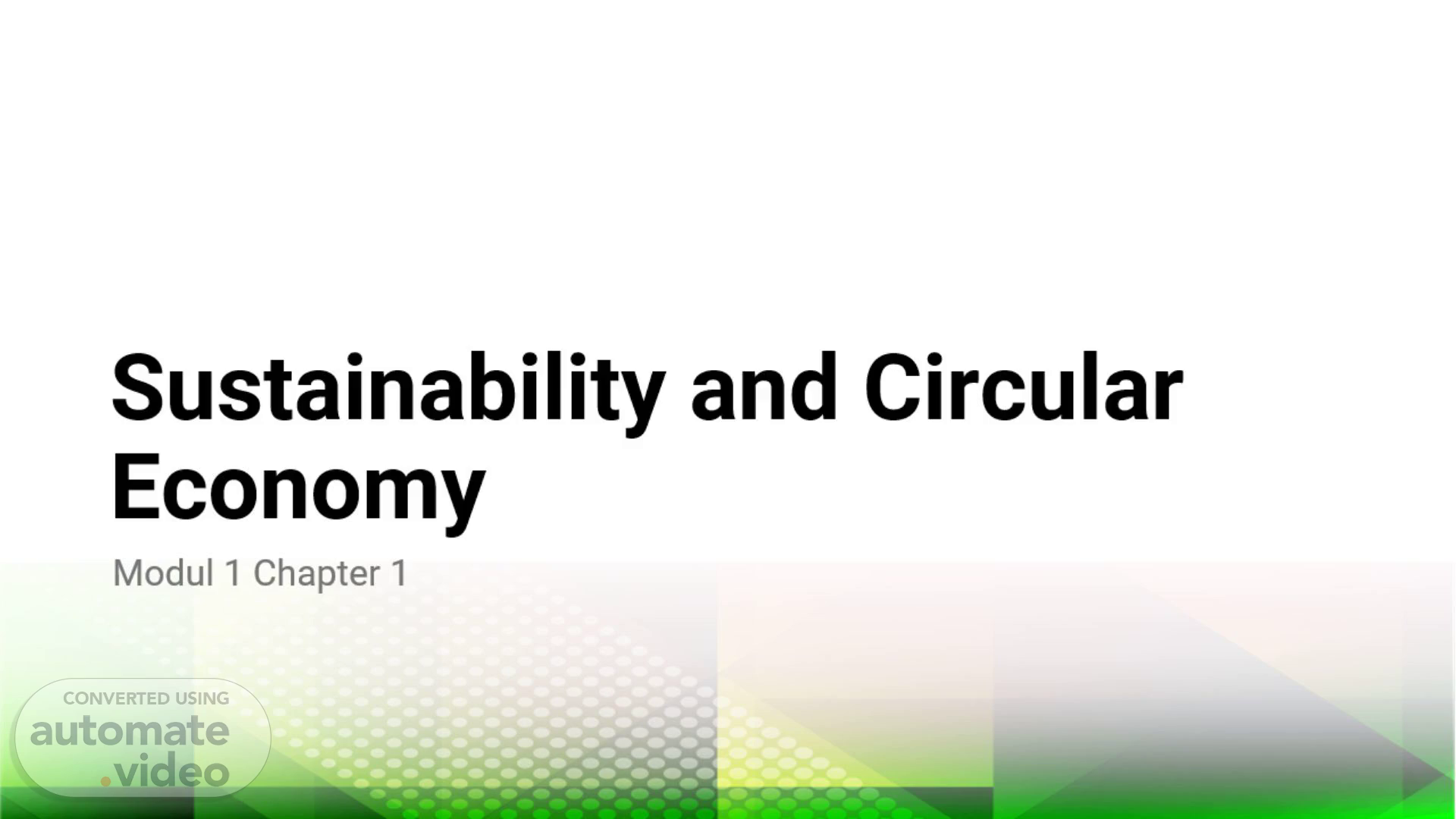Scene 1 (0s)
[Audio] Welcome to this presentation on Sustainability and Circular Economy. In this session, we will explore how sustainability principles intertwine with circular economy concepts to create business practices that are environmentally responsible, socially equitable, and economically viable. As the global community faces urgent challenges such as resource depletion, environmental degradation, and social inequality, it becomes crucial to shift from traditional, linear economic models toward more regenerative systems. This presentation aims to provide a comprehensive overview of these interconnected ideas, highlighting practical frameworks and examples that can help organizations operate more sustainably while maintaining economic competitiveness. By understanding and applying these concepts, businesses can contribute to a healthier planet and society for present and future generations..
Scene 2 (57s)
[Audio] This agenda outlines the structure and key topics of the first chapter on Sustainability and Circular Economy. We begin with an introduction that sets the stage by defining sustainability and the circular economy, and explaining why sustainable practices have become a moral imperative. Next, we cover the key aspects of sustainability, including the interconnectedness of species and ecosystems and the importance of adaptivity and resilience. We then explore how businesses can embed sustainability into their strategies to gain competitive advantage and respond to modern regulatory landscapes. Following that, the session delves into circular economy principles and future directions, offering a look at alternative economic models and innovative approaches. The chapter also presents important frameworks such as the Triple Bottom Line, Environmental, Social, and Governance criteria, and the United Nations Sustainable Development Goals. Finally, we will summarize the key concepts and pose reflective questions to encourage deeper thinking and application of the material..
Scene 3 (2m 5s)
[Audio] This section covers the critical intersection of sustainability and circular economy as a pathway to responsible business practices. Sustainability involves meeting present needs without compromising future generations, balancing environmental, social, and economic considerations. The circular economy offers an alternative to the traditional linear "take, make, dispose" model by emphasizing resource efficiency, reduced waste, and continuous reuse. Together, they aim to reduce environmental degradation and foster equitable economic development while maintaining profitability and resilience..
Scene 4 (2m 44s)
[Audio] Sustainability is not only an environmental or economic issue but a moral imperative. We must consider the long-term impacts of our actions on future generations, including economic debt, social disruption, resource scarcity, and climate crises. Ignoring these consequences would unfairly burden those who come after us. This imperative calls for a fundamental reevaluation of how organizations and societies operate, emphasizing stewardship, responsibility, and ethical decision-making to protect the planet and humanity..
Scene 5 (3m 20s)
[Audio] The global context is rapidly changing due to resource depletion, social inequalities, and cultural shifts. Businesses are increasingly recognizing their responsibility to integrate sustainability into their core operations. The most widely accepted definition of sustainability, originating with the Brundtland Commission in 1987, is meeting the needs of the present without compromising the ability of future generations to meet their own needs. This underscores the necessity of balancing immediate demands with long-term environmental and social well-being..
Scene 6 (3m 56s)
[Audio] Sustainability requires understanding the deep interconnections between species, ecosystems, and human systems. As Freeman (1984) emphasized, all stakeholders, including natural environments and communities, must be considered in decision-making. Business leaders are called to evaluate how current practices affect future generations across social, environmental, and cultural dimensions. This broader scope expands corporate responsibility beyond immediate economic performance..
Scene 7 (4m 30s)
[Audio] Sustainability is a dynamic, ongoing effort that demands constant adaptation and resilience. It involves multiple stakeholders, industries, and ecosystems cooperating in an interconnected web. Principles of adaptivity and resilience stress the ability to respond to changes while maintaining core values and functions. A holistic approach considers economic, social, environmental, and cultural factors to foster long-term system health and viability..
Scene 8 (5m 2s)
[Audio] Integrating sustainability into business strategy is increasingly seen as a competitive necessity. Companies embed these principles not only in response to regulatory pressures but also to mitigate risks, avoid crises, and capture new market opportunities. Sustainability can differentiate organizations by enhancing reputation, operational efficiency, and stakeholder trust, ultimately supporting financial success alongside positive environmental and social impact..
Scene 9 (5m 34s)
[Audio] Sustainability is now a core element of the modern corporate landscape. It encompasses eco-efficiency, eco-effectiveness, and corporate social responsibility with the overarching goal to foster ethical, responsible business ecosystems. Traditional business practices often fail to address global challenges, requiring transformative shifts toward sustainable models that ensure viability and align with international development goals..
Scene 10 (6m 3s)
[Audio] The circular economy focuses on keeping products, components, and materials in use for as long as possible, minimizing waste and maximizing resource efficiency. It offers environmental and social benefits while creating competitive advantages for businesses through innovation and sustainability leadership. Examples like Patagonia's repair programs, Dell's closed-loop recycling, IKEA's furniture buy-back, and Interface's net recycling initiative demonstrate successful circular economy implementation across industries..
